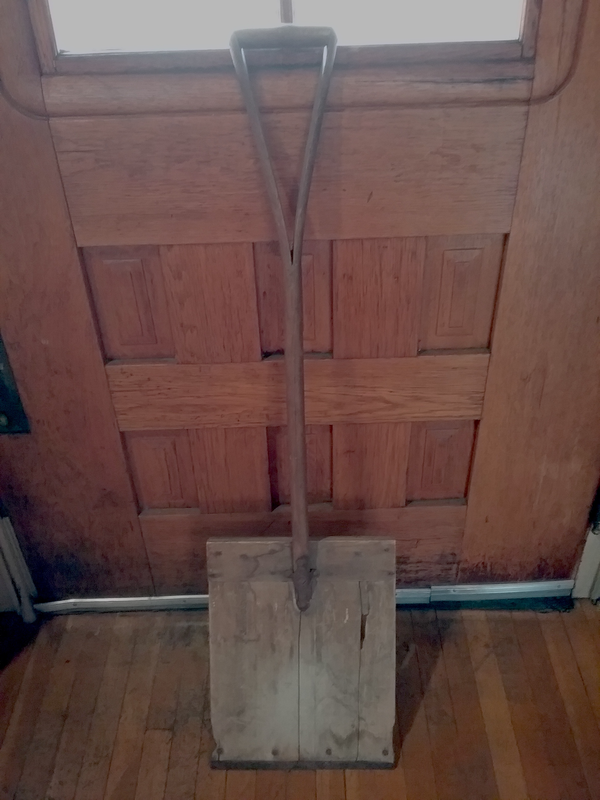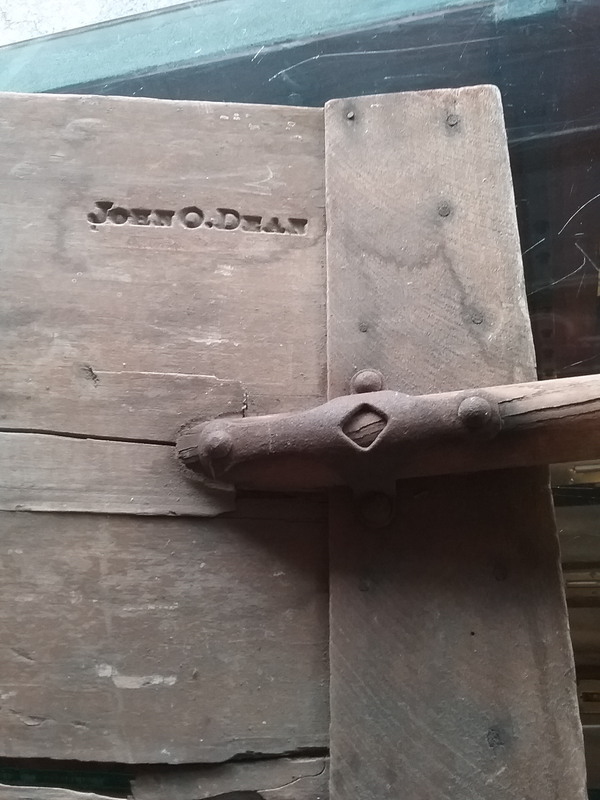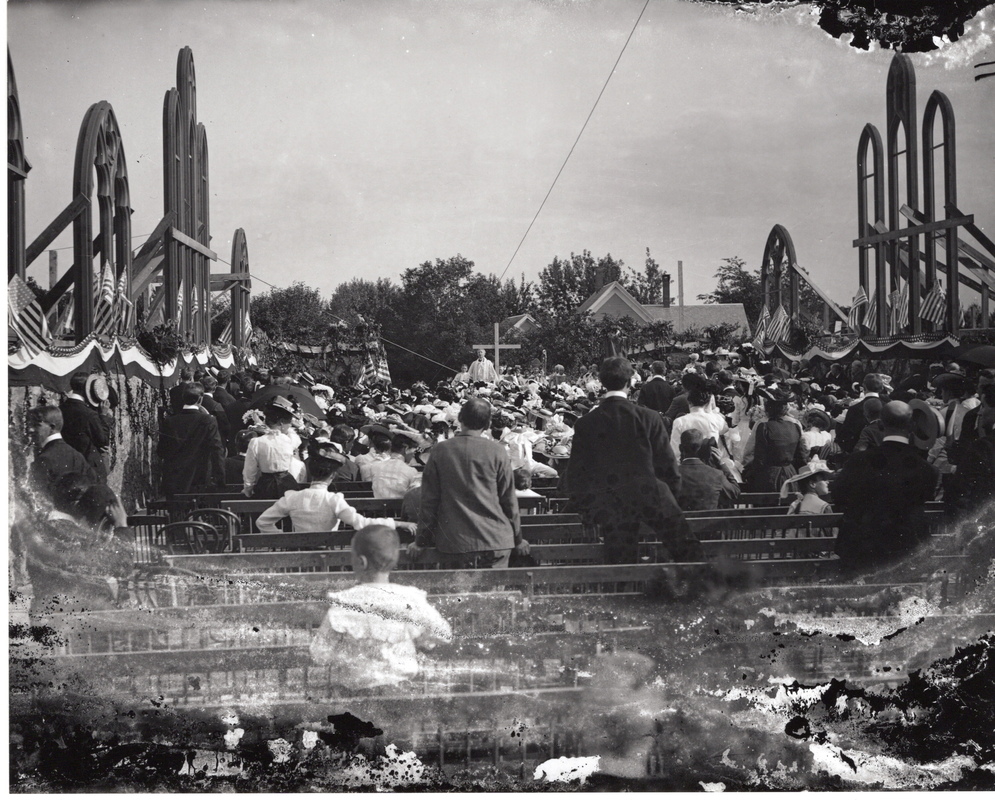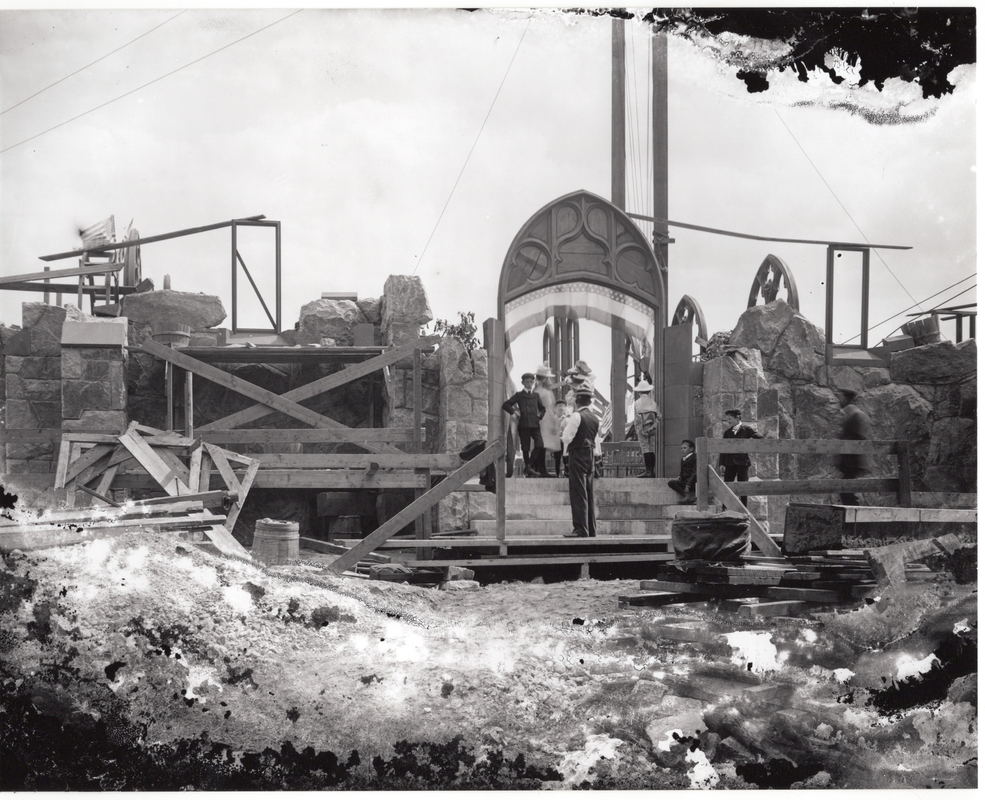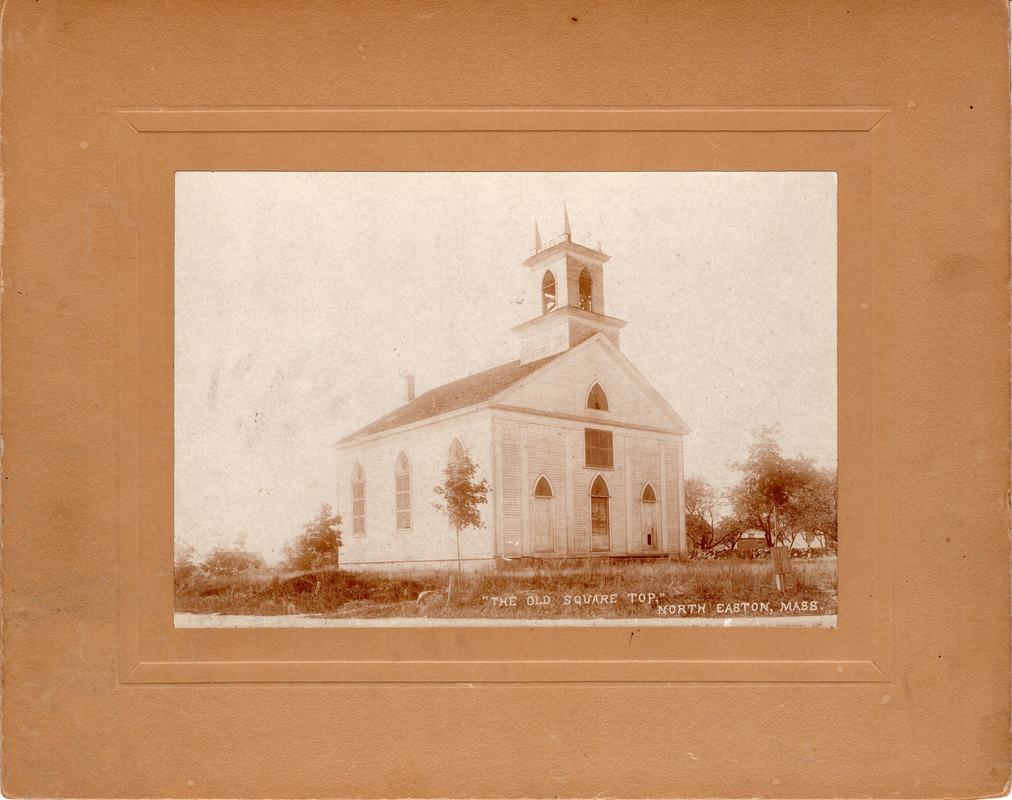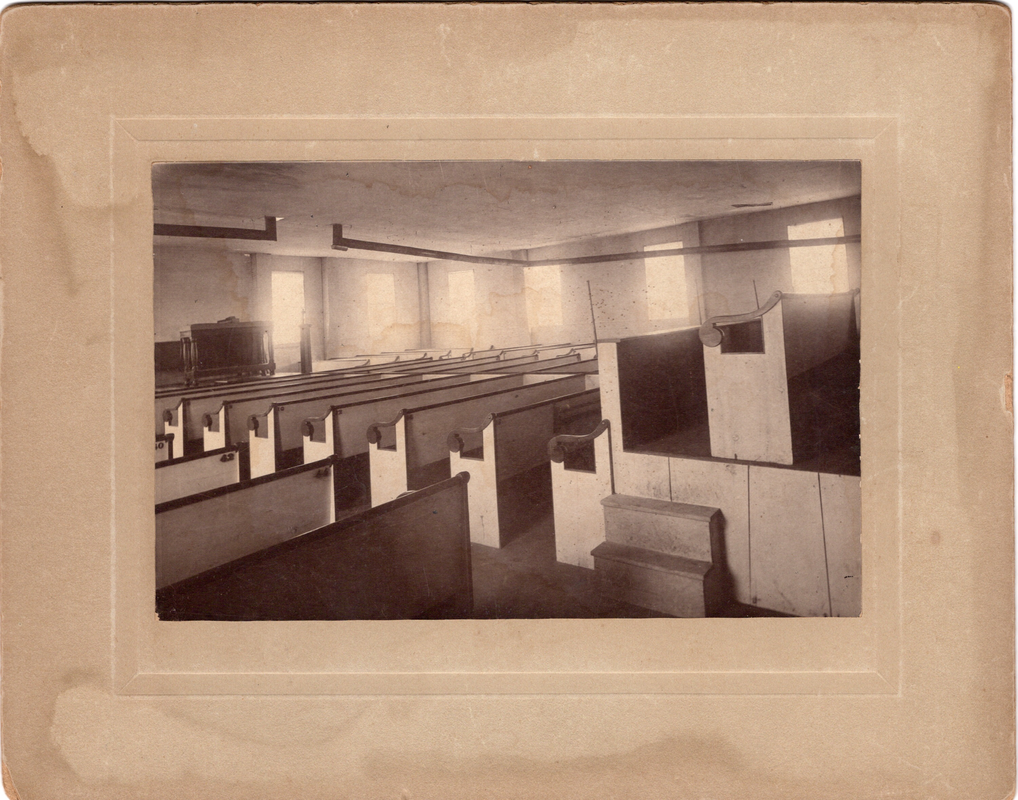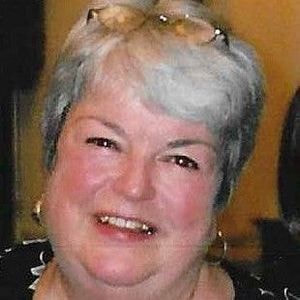|
Hello! No, it is not Saturday just yet. I am preparing to batten the hatches, as they say, in preparation for the arrival of the winter's first major snow storm! A blizzard warning is now in effect for all of Eastern Massachusetts, and 50+ MPH winds and 24" of snow are expected to impact a wide area. I think I'll spend tomorrow with a good book and a nice warm fire in the woodstove.
In the spirit of the season, today's timely update features something that will come in handy for days like tomorrow. John O. Dean (1835-1912) undoubtedly saw a few good blizzards in his life and understood the value of a sturdy shovel. Featured here is a great example of a New England snow shovel, dated to the third quarter of the 19th century. You will notice immediately that the shovel is made from wood! This is typical of snow shovels from this time. Wood is strong, resilient, and of course will not rust when used in wet weather or snow. The blade on this shovel shows a long period of use, but the shovel retains its original iron scraper at the base of the blade. As you can see in the detail, an iron flange and some rivets and washers are what holds the whole thing together. The shovel must have been valuable as well, since the name "John O. Dean " is stamped heavily into the wood blade. More than likely, this shovel didn't see a lot of snow. It was probably used inside Dean's old grain mill to coral loose hay or feed, which probably saved it from damage. Today it resides in the Museum, safe from ice and snow and all that wintry stuff! Stay safe, and stay well, and I'll see you after the blizzard! Frank
0 Comments
Hello from historic Easton! The cold temperatures in the last few days remind me of something I read in an old Easton newspaper a few years ago. The little quip stated something along the lines that all the school kids would get up and check their thermometers each winter morning. A reading of zero meant no school! School was not canceled because it was too cold to walk. It was canceled because the old coal furnaces could not heat the buildings in such cold temperatures!
Continuing our series on churches in Easton, today I share a few photos from the cornerstone laying and construction of the Immaculate Conception Church on Main Street. This building was the third erected for the fast-growing Catholic population in town, the first being the original chapel on Pond Street, which was followed by the wood church on Main Street later known as St. Mary's Hall. With a mortgage of $15,000 secured from North Easton Savings Bank, work began on the new building. On July 4th, 1902, a cornerstone laying ceremony took place. By that time, some of the church was under construction and pews and chairs could be set up on the floor so people could gather. Father James Looby led the ceremony which was attended by the Bishop of Providence, Most Reverend Matthew Harkins. The Bishop would return to attend the formal dedication of the building on April 19, 1904. The photos shown here include one from the cornerstone ceremony, and the Bishop can be seen seated on the altar platform to the right of the speaker, Father Looby. A large crowd has gathered for this open air event, dressed in summer finery and many of the ladies wore hats to keep the hot summer sun from beating down on them. Flags and buntings are placed throughout for the 4th of July. You can see the window frames erected and held in place with wood braces and some steel cables. In the center is the platform, site of the altar, where the honored guests are seated. The second photo is a nice image of the front door in place. A few interested people are checking out the progress being made, and it must have been very exciting to see the church erected. Did you know that the stone for the foundation and much of the church was quarried on site? Parishioner and stone mason Cornelius Dailey, Sr. directed that work. Both of these images are from glass negatives. Photos such as these give us some insight into construction techniques in use at the turn of the last century. I hope you all have a good week, stay well, and hopefully warm too! Frank Greetings from frigid Easton! We avoided the brunt of a passing storm last night, no rain, ice or snow. However, a brisk wind and cold temperatures sent us down close to zero overnight, and the wind chill was much too cold to even mention! Suffice it to say that the ride this morning was a cold one.
Hazel Varella is working on the next edition of "Reminiscences", and asks the following of our readers: "One of the features in this year's "Reminiscences" will be John Leonard, OAHS Class of 1948. In a "Providence Journal" article he was named one of the 100 Most Significant People in Rhode Island High School Sports in the 20th Century. In 2019 the Rhode Island Tennis Coaches awarded him a Lifetime Achievement Award. He died March 18, 2021. Anyone who would like to include a memory of John is asked to send it to [email protected]." We appreciate anyone who might be able to add to John's story. Last week I had several nice comments about the interior of the Old Square Top Methodist Church in Unionville. This week I am sending a photo of the church building proper. Taken around 1890-1895, shortly before it was razed around 1898, the church stood proudly on the northwest corner of Elm Street and Washington Street. Originally begun in a small building erected in 1795, the congregation outgrew the original church and a new building was erected in 1830. The square bell tower on the top of the structure gives the building its nickname. Over the years, a number of preachers held services here. At times, services were discontinued, and for several years the congregation merged with another Methodist group in North Easton village, and both buildings were used for six months at a time. A great revival, part of the "Great Awakening" movement, was held at this site in the 1850's, an event that is called the last big revival in New England. Among those who visited Easton was the First Bishop of the Methodist Episcopal Church in America, Francis Asbury, who preached the initial service in the original building, and the Rev. George Pickering, who preached at the dedication of the 1830 building. The congregation prospered enough to be the mother church to several other Methodist churches in Brockton and Stoughton. A favorite pastor was Rev. Louis "Father" Bates, whose son John, born in Easton, would become Governor of Massachusetts in the early 1900's. Records indicate that the last regular services were held at Old Square Top in 1885. The church fell into further disrepair, and was finally demolished. I do not know what happened to the bell from the church, nor does anything survive from the structure. Stay well, stay warm, and until next week, Frank Hello everyone! I hope this finds you well and off to a great start in the new year. We sadly had to cancel our planned open house, and as Covid cases continue to rise, we will see what happens in February. Easton saw its first significant snowfall of the winter yesterday, and temps here are going to drop into a high in the teens by Tuesday. I am already looking forward to spring!
Arielle Nathanson has been working through our collection of church records, and today's photo is one she recently scanned. It is a rare view of the interior of the "Old Square Top" Methodist Church on the northwest corner of Elm Street and Washington Street, across from the old Methodist burying ground on the opposite corner. Built around 1830, this was an upgrade from an earlier building built in 1795 and moved to Lincoln Street to make room for this building. I did say this was an upgrade, didn't I? Methodism reached its height in the area around this time, and over the succeeding years, a second Methodist church was added on Main Street. Old Square Top flourished for quite a while, drawing attendees from both Easton, Stoughton, and perhaps a few residents of North Bridgewater who lived near the Easton town line. The interior shown here is a classic New England Protestant Church of an early period. The interior is sparse, with no decorative features visible. The altar at the extreme left in the photo features a handsomely detailed table / pulpit, which may have even been considered a bit extravagant. It may be a later addition, as the original pulpit probably was the same one used in the 1795 building and would be much simpler in style. Pews are narrow and straightforward, utilizing a utilitarian design that served their intended purpose. There are plenty of windows, which was an improvement over the first building. Unfortunately, there was no insulation and winter attendees spent hours at a time in very cold conditions. The pipes running overhead would have originated in a coal stove, the only means of heat available in the building. A sexton would have to arrive very early on a Sunday morning to get the fire started if any heat was to be felt. Things were so cold, infact, that one would be allowed to bring a dog to church in the winter so you could have it warm your feet! By the way you also "purchased" your seat by paying a pew tax. If you look at the pews on the left, you can see that each row is numbered so your pew could be "sold" to you. Pews near the front would be the most expensive, those in the rear the least expensive, and those on the sides somewhere in the middle of that. Seating in churches in those days was a direct reflection on your social status and success. By the late 1800's, this congregation had dwindled and joined other Methodist churches in the area, and the building was finally razed in 1898. Until next week, stay well and stay warm, Frank Hello all,
As you know, Covid is running very high in Massachusetts as it is in other parts of the United States. The high number of cases, coupled with a high infection rate, means we will not be holding our January open house as we hoped to do. We will be re-evaluating each month as Covid numbers change. We hope you all stay well, and we look forward to reopening as soon as it is safe to do so. With best wishes for good health, Frank -- Frank T. Meninno Curator, Easton Historical Society and Museum 508-238-7774 www.eastonmahistoricalsociety.org We are sharing sad news today. Patricia Baker, a director and long time member of the Easton Historical Society, passed away. Patricia Baker Obituary - Easton, Massachusetts - Kane Funeral Home & Cremation Services (tributes.com)
|
Author
Anne Wooster Drury Archives
June 2024
Categories |
Easton Historical Society and Museum
PO Box 3
80 Mechanic Street
North Easton, MA 02356
Tel: 508-238-7774
[email protected]

